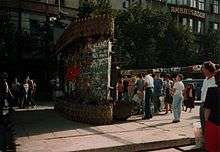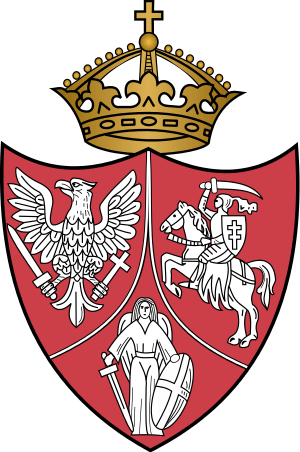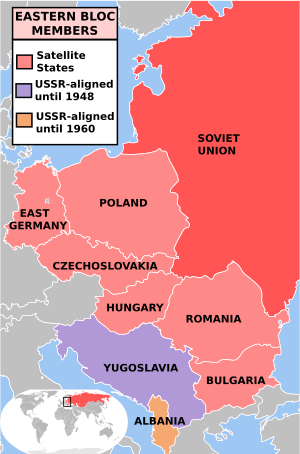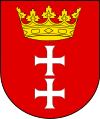Solidarity (Polish trade union)
Solidarity (Polish: Solidarność, pronounced [sɔlʲiˈdarnɔɕtɕ] (![]()
_(logo).png) | |
| Full name | Independent Self-governing Trade Union "Solidarity" |
|---|---|
| Native name | Niezależny Samorządny Związek Zawodowy "Solidarność" |
| Founded | (recognition) 31 August 1980 (1st Congress) 17 September 1980[1] (registration) 10 November 1980 |
| Members | Almost 10 million at the end of the first year; over 400,000 in 2011[2] (680,000 in 2010)[3] |
| Affiliation | ITUC, ETUC, TUAC |
| Key people | Anna Walentynowicz, Lech Wałęsa |
| Office location | Gdańsk, Poland |
| Country | Poland |
| Website | Solidarnosc.org.pl (in English) |
| Eastern Bloc | |||||||
|---|---|---|---|---|---|---|---|
 | |||||||
|
Allied states
|
|||||||
|
Related organizations |
|||||||
|
Dissent and opposition
|
|||||||
In the 1980s, Solidarity was a broad anti-bureaucratic social movement, using methods of civil resistance to advance the causes of workers' rights and social change.[6] Government attempts in the early 1980s to destroy the union through the imposition of martial law in Poland and the use of political repression failed. Operating underground, with significant financial support from the Vatican and the United States, estimated to be as much as US$50 million,[7] the union survived and by the latter 1980s had entered into negotiations with the government.
The 1989 round table talks between the government and the Solidarity-led opposition produced agreement for the 1989 legislative elections, the country's first pluralistic election since 1947. By the end of August, a Solidarity-led coalition government was formed and in December 1990, Wałęsa was elected President of Poland.
Following Poland's transition to liberal capitalism in the 1990s and the extensive privatization of state assets, Solidarity's membership and influence declined significantly; by 2010, 30 years after being founded, the union had lost more than 90% of its original membership.
History
In the 1970s Poland's government raised food prices while wages were stagnant. This and other stresses led to protests in 1976 and a subsequent government crackdown on dissent. The KOR, the ROPCIO and other groups began to form underground networks to monitor and oppose the government's behavior. Labour unions formed an important part of this network.[8] In 1979, the Polish economy shrank for the first time since World War II, by 2 percent. Foreign debt reached around $18 billion by 1980.[9]
Anna Walentynowicz was fired from the Gdańsk Shipyard on 7 August 1980, five months before she was due to retire, for participation in the illegal trade union. This management decision enraged the workers of the shipyard, who staged a strike action on 14 August defending Anna Walentynowicz and demanding her return. She and Alina Pienkowska transformed a strike over bread and butter issues into a solidarity strike in sympathy with strikes on other establishments.
Solidarity emerged on 31 August 1980 at the Gdańsk Shipyard when the communist government of Poland signed the agreement allowing for its existence. On 17 September 1980, over twenty Inter-factory Founding Committees of free trade unions merged at the congress into one national organization NSZZ Solidarity.[5] It officially registered on 10 November 1980.[10]
Lech Wałęsa and others formed a broad anti-Soviet social movement ranging from people associated with the Catholic Church[11] to members of the anti-Soviet left. Polish nationalism, together with pro-American liberalism, played an important part in the development of Solidarity in the 1980s.[12] Solidarity advocated non-violence in its members' activities.[13][14] In September 1981, Solidarity's first national congress elected Wałęsa as a president[10] and adopted a republican program, the "Self-governing Republic".[15] The government attempted to destroy the union with the martial law of 1981 and several years of repression, but in the end it had to start negotiating with the union.
Roundtable Talks between the government and Solidarity-led opposition led to semi-free elections in 1989. By the end of August a Solidarity-led coalition government was formed, and in December Tadeusz Mazowiecki was elected Prime Minister. Since 1989, Solidarity has become a more traditional trade union, and had relatively little impact on the political scene of Poland in the early 1990s. A political arm founded in 1996 as Solidarity Electoral Action (AWS) won the parliamentary election in 1997, but lost the following 2001 election. Currently, as a political party Solidarity has little influence on modern Polish politics.
CIA covert support
In the year leading up to martial law, Reagan Administration policies supported the Solidarity movement, waging a public relations campaign to deter what the Carter administration had seen as "an imminent move by large Soviet military forces into Poland."[16] Michael Reisman from Yale Law School named operations in Poland as one of the covert regime change actions of the CIA during the Cold War.[17] Colonel Ryszard Kukliński, a senior officer on the Polish General Staff, was secretly sending reports to CIA officer David Forden.[18] The Central Intelligence Agency (CIA) transferred around $2 million yearly in cash to Solidarity, for a total of $10 million over five years. There were no direct links between the CIA and Solidarnosc, and all money was channeled through third parties.[19] CIA officers were barred from meeting Solidarity leaders, and the CIA's contacts with Solidarnosc activists were weaker than those of the AFL-CIO, which raised $300,000 from its members, which were used to provide material and cash directly to Solidarity, with no control of Solidarity's use of it. The U.S. Congress authorized the National Endowment for Democracy to promote democracy, and the NED allocated $10 million to Solidarity.[20]
The Polish government enacted martial law in December 1981, however, Solidarity was not alerted. Potential explanations for this vary; some believe that the CIA was caught off guard, while others suggest that American policy-makers viewed an internal crackdown as preferable to an "inevitable Soviet intervention."[21] CIA support for Solidarity included money, equipment and training, which was coordinated by Special Operations.[22] Henry Hyde, U.S. House intelligence committee member, stated that the USA provided "supplies and technical assistance in terms of clandestine newspapers, broadcasting, propaganda, money, organizational help and advice".[23] Initial funds for covert actions by CIA were $2 million, but soon after authorization were increased and by 1985 CIA successfully infiltrated Poland.[24]
Relations with the Catholic Church
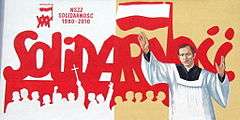
In 2017, Solidarity backed a proposal to implement blue laws to prohibit Sunday shopping, a move supported by Polish bishops.[25] A 2018 new Polish law banning almost all trade on Sundays has taken effect, with large supermarkets and most other retailers closed for the first time since liberal shopping laws were introduced in the 1990s. The Law and Justice party passed the legislation with the support of Prime Minister Mateusz Morawiecki.[26][27][28][29]
Secular philosophical underpinnings
Although Leszek Kołakowski's works were officially banned in Poland, and he lived outside the country from the late 1960s, the philosopher's ideas nonetheless exerted an influence on the Solidarity movement. Underground copies of his books and essays shaped the opinions of the Polish intellectual opposition. His 1971 essay Theses on Hope and Hopelessness, which suggested that self-organized social groups could gradually expand the spheres of civil society in a totalitarian state, helped inspire the dissident movements of the 1970s that led to the creation of Solidarity and provided a philosophical underpinning for the movement.
Kołakowski later described Solidarity as "perhaps [the] closest to the working class revolution" that Karl Marx had predicted in the mid-1800s. Ironically, however, Solidarity featured many elements contrary to socialism as conceived by Marx: "[workers organized] against the exploiters, that is to say, the state. And this solitary example of a working class revolution (if even this may be counted) was directed against a socialist state, and carried out under the sign of the cross, with the blessing of the Pope."[30]
Influence abroad
The survival of Solidarity was an unprecedented event not only in Poland, a satellite state of the USSR ruled (in practice) by a one-party Communist regime, but the whole of the Eastern bloc. It meant a break in the hard-line stance of the communist Polish United Workers' Party, which had bloodily ended a 1970 protest with machine-gun fire (killing over thirty and injuring over 1,000), and the broader Soviet communist government in the Eastern Bloc, which had quelled both the 1956 Hungarian Uprising and the 1968 Prague Spring with Soviet-led invasions.
Solidarity's influence led to the intensification and spread of anti-communist ideals and movements throughout the countries of the Eastern Bloc, weakening their communist governments. As a result of the Round Table Agreement between the Polish government and the Solidarity-led opposition, elections were held in Poland on 4 June 1989, in which the opposition was allowed to field candidates against the Communist Party—the first free elections in any Soviet bloc country. A new upper chamber (the Senate) was created in the Polish parliament and all of its 100 seats were contestable in the election, as well as one-third of the seats in the more important lower chamber (the Sejm). Solidarity won 99 of the 100 Senate seats and all 161 contestable seats in the Sejm—a victory that also triggered a chain reaction across the Soviet Union's satellite states, leading to almost entirely peaceful anti-communist revolutions in Central and Eastern Europe[11] known as the Revolutions of 1989 (Jesień Ludów or Wiosna Obywatelów), which ended in the overthrow of each Moscow-imposed regime, and ultimately to the dissolution of the Soviet Union in the early 1990s.
Given the union's support from many western governments, relations with trade unions in capitalist countries could be complicated. For example, during the UK miners' strike of 1984–85, Wałęsa said that "The miners should fight, but with common sense—not with destruction" and said of Margaret Thatcher "With such a wise and brave woman, Britain will find a solution to the strike." However, David Jastrzębski, the president of Upper Silesia Solidarity, voiced his support of the striking miners: "Neither the British government's mounted police charges nor its truncheon blows, any more than the Polish junta's tanks or rifle fire, can break our common will to struggle for a better future for the working class."[31] This was despite the fact that Arthur Scargill, president of the British National Union of Mineworkers had been highly critical of Solidarity, condemning it as an "anti-socialist organization which desires the overthrow of a socialist state".[32]
In 2005, the trade union Solidarity – The Union for British Workers was created in honour of the original Polish union by the far-right British National Party.
In late 2008, several democratic opposition groups in the Russian Federation formed a Solidarity movement.[33]
In the United States, the American Solidarity Party (formerly the Christian Democratic Party USA), a Christian democratic political party, attributes its namesake to Solidarity.[34]
In a 2011 essay "The Jacobin Spirit" in the American magazine Jacobin, philosopher Slavoj Zizek called Solidarnosc' one of the "free spaces at a distance from state power" that used "defensive violence" to protect itself from state control. The notion of "defensive violence" runs in the vein of ideas postulated by Alain Badiou.[35]
Organization
The union was officially founded on 17 September 1980,[1] the union's supreme powers were vested in a legislative body, the Convention of Delegates (Zjazd Delegatów). The executive branch was the National Coordinating Commission (Krajowa Komisja Porozumiewawcza), later renamed the National Commission (Komisja Krajowa). The Union had a regional structure, comprising 38 regions (region) and two districts (okręg). At its highest, the Union had over 10 million members, which became the largest union membership in the world. During the communist era the 38 regional delegates were arrested and jailed when martial law came into effect on 13 December 1981 under General Wojciech Jaruzelski. After a one-year prison term the high-ranking members of the union were offered one way trips to any country accepting them (including Canada, the United States, and nations in the Middle East).
Solidarity was organized as an industrial union, or more specifically according to the One Big Union principle, along the lines of the Industrial Workers of the World and the Spanish Confederación Nacional del Trabajo (workers in every trade were organized by region, rather than by craft).[36]
In 2010, Solidarity had more than 400,000 members.[2] National Commission of Independent Self-Governing Trade Union is located in Gdańsk and is composed of Delegates from Regional General Congresses.
Regional structure
Solidarity is divided into 37 regions, and the territorial structure to a large degree reflects the shape of Polish voivodeships, established in 1975 and annulled in 1998 (see: Administrative division of People's Republic of Poland). The regions are:
- Gdańsk, based in Gdańsk,
- Warmia-Masuria, based in Olsztyn,
- Elbląg, based in Elbląg,
- Lower Silesia, based in Wrocław,
- Pila, based in Piła,
- Western Pomerania, based in Szczecin,
- Land of Łódź, based in Łódź,
- Częstochowa, based in Częstochowa,
- Land of Sandomierz, based in Stalowa Wola,
- Płock-Kutno, based in Płock,
- Lesser Poland, based in Kraków,
- Opole Silesia, based in Opole,
- Seashore, based in Koszalin,
- Słupsk, based in Słupsk,
- Zielona Góra, based in Zielona Góra,
- Podbeskidzie, based in Bielsko-Biała,
- Konin, based in Konin,
- Southern Greater Poland, based in Kalisz,
- Podlachia, based in Białystok,
- Piotrków, based in Piotrków Trybunalski,
- Cuiavia and Dobrzyń Land, based in Włocławek,
- Carpathia, based in Krosno,
- Land of Rzeszów, based in Rzeszów,
- Toruń, based in Toruń,
- Silesia-Zaglebie, based in Katowice,
- Land of Radom, based in Radom,
- Greater Poland, based in Poznań,
- Gorzów, based in Gorzów Wielkopolski,
- Holy Cross, based in Kielce,
- Middle-East, based in Lublin,
- Bydgoszcz, based in Bydgoszcz,
- Jelenia Góra, based in Jelenia Góra,
- Leszno, based in Leszno,
- Chełm, based in Chełm,
- Przemyśl-Jarosław, based in Przemyśl,
- Mazovia, based in Warsaw,
- Copper Basin, based in Legnica.
Network of key factories
The network of Solidarity branches of the key factories of Poland was created on 14 April 1981 in Gdańsk. It was made of representatives of seventeen factories; each stood for the most important factory of every voivodeship of the pre-1975 Poland (see: Administrative division of People's Republic of Poland). However, there were two exceptions. There was no representative of the Koszalin Voivodeship, and the Katowice Voivodeship was represented by two factories:
| Voivodeship | Represented by |
|---|---|
| Gdańsk | Vladimir Lenin Shipyard in Gdańsk |
| Szczecin | Szczecin Shipyard |
| Poznań | H. Cegielski - Poznań S.A. |
| Bydgoszcz | Rail Vehicles Repair Shop |
| Zielona Góra | Rolling Stock and Steel Works Zastal in Zielona Góra |
| Katowice | Wujek Coal Mine in Katowice |
| The Spare Parts Factory Zgoda in Świętochłowice | |
| Koszalin | No representative |
| Kraków | Vladimir Lenin Steelworks in Nowa Huta |
| Wrocław | Rail Carriage Factory Pafawag in Wrocław |
| Rzeszów | Factory of Communication Equipment WSK in Rzeszów |
| Białystok | Cotton Works Fasty in Białystok |
| Kielce | Ball Bearings Factory Iskra in Kielce |
| Olsztyn | Tire Company Stomil in Olsztyn |
| Lublin | Factory of Communication Equipment PZL in Świdnik |
| Łódź | Julian Marchlewski Cotton Works in Łódź |
| Warsaw | Ursus Factory in Warsaw |
| Opole | Malapanew Steelworks in Ozimek |
Chairmen
- Lech Wałęsa (1980–1991)
- Marian Krzaklewski (1991–2002)
- Janusz Śniadek (2002–2010)
- Piotr Duda (2010–present)
See also
- 1981 warning strike in Poland
- 1988 Polish strikes
- 31 August 1982 demonstrations in Poland
- Civil resistance
- Conference of Solidarity Support Organizations
- European Solidarity Centre
- Fighting Solidarity
- Jastrzębie-Zdrój 1980 strikes
- June 1976 protests
- Lublin 1980 strikes
- Polish 1970 protests
- 1989 Polish legislative election
- Hungarian Solidarity Movement
- Solidarnost
- Summer 1981 hunger demonstrations in Poland
References
- Guardian newspaper report Retrieved 22 June 2009
- (in Polish) 30 lat po Sierpniu'80: "Solidarność zakładnikiem własnej historii" Archived 29 October 2013 at the Wayback Machine Retrieved on 7 June 2011
- (in Polish) Duda za Śniadka? by Maciej Sandecki and Marek Wąs, Gazeta Wyborcza of 24 August 2010
- Stanley, John (14 April 2015). "Sex and Solidarity, 1980–1990". Canadian Slavonic Papers. 52 (1–2): 131–151. doi:10.1080/00085006.2010.11092641. JSTOR 40871520.
- (in Polish) "Solidarność" a systemowe przekształcenia Europy Środkowo-Wschodniej Archived 7 August 2013 at the Wayback Machine Retrieved on 7 June 2011
- Aleksander Smolar, '"Self-limiting Revolution": Poland 1970–89', in Adam Roberts and Timothy Garton Ash (eds.), Civil Resistance and Power Politics: The Experience of Non-violent Action from Gandhi to the Present, Oxford University Press, 2009, ISBN 978-0-19-955201-6, pp. 127–43.
- Tony Judt (2005). Postwar: A History of Europe Since 1945. The Penguin Press. p. 589.
- KOR: a history of the Workers' Defense Committee in Poland, 1976–1981. Berkeley: University of California Press. 1985. ISBN 0-520-05243-9.
- Paczkowski, Andrzej; Byrne, Malcolm; Domber, Gregory F.; Klotzbach, Magdalena (2007). "1970s". From Solidarity to Martial Law: The Polish Crisis of 1980–1981. Central European University Press. p. xxix. ISBN 978-963-7326-96-7.
- (in Polish) Solidarność, wielopłaszczyznowy ruch na rzecz demokratyzacji i głębokich reform ustrojowych PRL Retrieved on 7 June 2011
- Steger, Manfred B (January 2004). Judging Nonviolence: The Dispute Between Realists and Idealists (ebook). Routledge (UK). p. 114. ISBN 0-415-93397-8. Retrieved 9 July 2006.
- Paul Wehr; Guy Burgess; Heidi Burgess, eds. (February 1993). Justice Without Violence (ebook). Lynne Rienner Publishers. p. 28. ISBN 1-55587-491-6. Retrieved 6 July 2006.
- Cavanaugh-O'Keefe, John (January 2001). Emmanuel, Solidarity: God's Act, Our Response (ebook). Xlibris Corporation. p. . ISBN 0-7388-3864-0. Retrieved 6 July 2006.
Solidarity Poland nonviolence.
- Gliński, Piotr (2006). "The Self-governing Republik in the Third Republic". Polish Sociological Review. 153 (1): 55–74. JSTOR 41274953.
- MacEachin, Douglas J. (2000). US Intelligence and the Polish Crisis: 1980–1981. cia.gov. Center for the Study of Intelligence. ISBN 9781929667062. Retrieved 10 June 2019.
- Arsanjani, Mahnoush H.; Cogan, Jacob, eds. (2010). Looking to the Future: Essays on International Law in Honor of W. Michael Reisman. Martinus Nijhoff Publishers. p. 102. ISBN 978-90-04-17361-3.
- Davies, Richard T. (2004). "The CIA and the Polish Crisis of 1980–1981". Journal of Cold War Studies. 6 (3): 120–123. doi:10.1162/1520397041447346.
- Gregory F. Domber (2008). Supporting the Revolution: America, Democracy, and the End of the Cold War in Poland, 1981—1989. p. 199. ISBN 9780549385165., revised as Domber 2014, p. 110 .
- Domber, Gregory F. (28 August 2014), What Putin Misunderstands about American Power, University of California Press Blog, University of North Carolina PressCS1 maint: ref=harv (link)
- MacEachin, Douglas J. "US Intelligence and the Polish Crisis 1980–1981." CIA. 28 June 2008.
- Cover Story: The Holy Alliance By Carl Bernstein Sunday, 24 June 2001
- Sussman, Gerald (2010). Branding Democracy: U.S. Regime Change in Post-Soviet Eastern Europe. Peter Lang. p. 128. ISBN 978-1-4331-0531-9.
- Daugherty, William (2006). Executive Secrets: Covert Action and the Presidency. University Press of Kentucky. pp. 201–203. ISBN 978-0-8131-7196-8.
- "Polish bishops back Sunday trading ban". BBC News. 23 August 2017.
- Gera, Vanessa (11 March 2018). "Most Stores Shut in Poland as Sunday Trade Ban Takes Effect". U.S. News & World Report. Associated Press.
- Gera, Vanessa (11 March 2018). "Stores shut across Poland as Sunday shopping ban takes effect". Global News. Associated Press.
- "Sunday trading ban comes into effect in Poland". RTÉ News. 11 March 2018.
- "Stores closed as Poland phases out Sunday shopping". Polskie Radio dla Zagranicy. 11 March 2018.
- Leszek Kołakowski. What Is Left of Socialism. First Things, October 2002
- "Workers unite, east and west!". Workers' Liberty. Alliance for Workers' Liberty. 8 October 2009. Retrieved 29 January 2017.
- McKinlay, John (8 September 1983). "Scargill angers unions with Solidarity attack". The Glasgow Herald. Retrieved 1 September 2014.
- Kasparov starts new Russian opposition movement. The Associated Press. 13 December 2008. }
- Gehrz, Chris (16 August 2016). "Could the U.S. Finally Get a Significant Christian Democratic Party?". Patheos. Retrieved 16 August 2016.
The nominees of the American Solidarity Party (ASP), which takes its name from the Polish movement of the late Cold War and calls itself "the only active Christian Democratic party in the United States."
- "The Jacobin Spirit".
- (in Polish) Solidarność NSZZ in WIEM Encyklopedia. Last accessed on 10 October 2006
Further reading
- Domber, Gregory G. (2016). Empowering Revolution: America, Poland, and the End of the Cold War. Dodd Mead. ISBN 978-1469629810.
- Eringer, Robert (1982). Strike for Freedom: The Story of Lech Wałęsa and Polish Solidarity. The University of North Carolina Press. ISBN 0-396-08065-0.
- Goddeeris, Idesbald (2002). The Polish Revolution: Solidarity. Yale University Press. ISBN 0-300-09568-6.
- Garton Ash, Timothy (2012). Solidarity with Solidarity: Western European Trade Unions and the Polish Crisis, 1980–1982. Lexington Books. ISBN 978-0739150719.
- Kaminski, Marek M. (2004). Games Prisoners Play. Princeton University Press. ISBN 0-691-11721-7.
- Kenney, Patrick (2003). A Carnival of Revolution : Central Europe 1989. Princeton University Press. ISBN 0-691-11627-X.
- Kenney, Patrick (2006). The Burdens of Freedom. Zed Books Ltd. ISBN 1-84277-662-2.
- Kubik, Jan (1994). The Power of Symbols Against the Symbols of Power: The rise of Solidarity and the fall of state socialism in Poland. The Pennsylvania State University. ISBN 0-271-01084-3.
- Ledger, Robert. "From Solidarity to 'Shock Therapy'. British Foreign Policy Towards Poland Under the Thatcher Government, 1980–1990." Contemporary British History 30#1 (2016): 99-118.
- Matynia, Elzbieta (2009). Performative Democracy. Paradigm. ISBN 978-1594516566.
- Osa, Maryjane (2003). Solidarity and Contention: Networks of Polish Opposition. University of Minnesota Press. ISBN 0-8166-3874-8.
- Ost, David (2005). The Defeat of Solidarity: Anger and Politics in Postcommunist Europe (ebook). Cornell University Press. ISBN 0-8014-4318-0.
- Penn, Shana (2005). Solidarity's Secret : The Women Who Defeated Communism in Poland. University of Michigan Press. ISBN 0-472-11385-2.
- Perdue, William D. (1995). Paradox of Change: The Rise and Fall of Solidarity in the New Poland. Praeger/Greenwood. ISBN 0-275-95295-9.
- Pope John Paul II, Sollicitudo rei socialis, on Vatican website
- Staniszkis, Jadwiga (1984). Poland's Self-Limiting Revolution. Princeton University Press.
- Smolar, Aleksander, '"Self-limiting Revolution": Poland 1970–89', in Adam Roberts and Timothy Garton Ash (eds.), Civil Resistance and Power Politics: The Experience of Non-violent Action from Gandhi to the Present, Oxford: Oxford University Press, 2009. ISBN 978-0-19-955201-6..
- Szporer, Michael (2014). Solidarity: The Great Workers Strike of 1980. Lexington Books. ISBN 978-0739192801.
- Weigel, George (1992). The Final Revolution: The Resistance Church and the Collapse of Communism. Oxford University Press. ISBN 0-19-516664-7.
External links
| Polish Wikisource has original text related to this article: |
| Wikimedia Commons has media related to Solidarność. |
- Official website
- Presentation on The Solidarity Phenomenon
- FAES The Polish trade Union Solidarity and the European idea of freedom
- Solidarity 25th Anniversary Press Center
- Who is Anna Walentynowicz?, a documentary film about Solidarity
- Katherine Kenning collection of Joanna Wojciechowicz papers, MSS 8081 at L. Tom Perry Special Collections, Brigham Young University. Contains materials about Wojciechowicz's participation in the Solidarity movement.
- International Conference 'From Solidarity to Freedom'
- Advice for East German propagandists on how to deal with the Solidarity movement
- The Birth of Solidarity on BBC
- Solidarity, Freedom and Economical Crisis in Poland, 1980–81
- Solidarność collection at the Libertarian Communist library
- Solidarność from Gdańsk to Military Repression by Colin Barker and Kara Weber (1982)
- Arch Puddington, How American Unions Helps Solidarity Win
- Motion for a resolution, the European Parliament on the 25th anniversary of Solidarity and its message for Europe
- Solidarity Lost, by Daniel Singer
- (in Polish) Solidarity Center Foundation – Fundacja Centrum Solidarności
- A Simple Way to Learn an Old Song A radio programme about the song "Mury", the anthem of Solidarność. In Russian with English transcript
